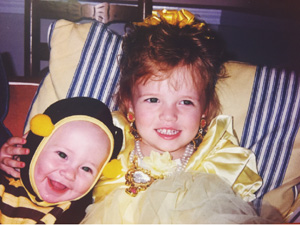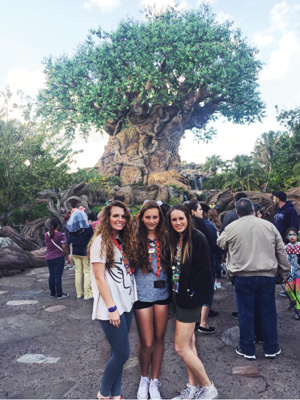Posted on Jan 30, 2018 in
COLLEGE DAZE
By Kassidi McKayla Kaminski

 Kassidi McKayla Kaminski is a sophomore studying Psychology in the Liberal Arts Honors Program at The University of Texas at Austin. After graduation she hopes to attend law school and is currently a member of Delta Gamma and a Young Life leader at Reagan High School.
Kassidi McKayla Kaminski is a sophomore studying Psychology in the Liberal Arts Honors Program at The University of Texas at Austin. After graduation she hopes to attend law school and is currently a member of Delta Gamma and a Young Life leader at Reagan High School.
When I was a junior in high school, I wrote a twenty-page research paper on Walt Disney. Walt is a legend to me. He was a man with humble roots in Missouri and no money or credibility. He insisted his employees call him by his first name. He had the tenacity to hold onto a dream that he knew would change the world – a dream that appeals to every child of any race, color or creed, one that allots each of them the courage to pursue life’s little magic.

Notice how it’s called Cinderella’s Castle. Prince Charming who?
As a kid who grew up without cable television, my only exposure to technicolor outside of my local PBS station was a library of Disney films. I had memorized every word in Tarzan, and I could recall the titles of every Disney movie before I learned how to read in school. And as I grew in wisdom and stature, so evolved the messages in Disney films. From Walt’s personal film ideas to the ones implemented after his death, themes of feminism gradually dominated Disney’s princess films and addressed the social concerns of the time period.
Feminism in early princess classics are subtle at best. Walt himself oversaw Snow White, Cinderella, and Aurora (Sleeping Beauty) before his death in 1966. A typical “happily ever after” with Prince Charming cues the end of each princess’ story. Although their endings are clearly male-oriented, Walt still succeeds in developing each princess as a brave woman with attainable dreams. Whether she thwarts a murderous stepmother or flees a life of neglect, these princesses display individualized character development before the introduction of their male counterparts. For many viewers, however, this was not enough.
Times quickly changed after Walt died. After three decades of a rising feminist movement, the Disney company produced a string of princess films in the late 80s and 90s, a period referred to as “The Disney Renaissance.” These movies initiated a trend of films with stronger female protagonists –
and Prince Charming afterthoughts. While each princess in this era finds her happily-ever-after-prince, the romantic relationship is not the main focus. For the first time, Disney films explicitly exposed young girls to the special power and courage of female heroism.

Me as Belle and Kolton as a bee on Halloween. Belle was always my favorite princess growing up due to her love of books. I was (am) so jealous of her library.
Each princess movie of the Renaissance exhibits a different attribute of female empowerment. The Little Mermaid redefined what it means to be “the perfect daughter.” Ariel dared girls to be adventurous and to keep pursuing their questions of the world around them, regardless of who tries to stop them. A Chinese commoner’s daughter-turned-war-hero follows this theme of redefining the feminine norm. Mulan showed girls that society does not dictate a required mold for them. It insists that a woman has just as much strength as a man to defend both her country and her family with patriotism and loyalty.
In a world dominated by patriarchy, women can excel in education to prove themselves “worthy” of their male counterparts. In Beauty and the Beast, Belle retains the title of the village’s oddball for her love of reading. In an atmosphere that condemns her for her literary prowess, Belle shows young girls that being well-read gleans a special intellectual power and that filling one’s mind with literature about far-off places can give meaning to an otherwise “provincial life.”
But the feminist commentary doesn’t stop here. In three of the company’s most recent princess releases, there is no male love interest for the film’s main characters. These movies instead focus on three girls fulfilling their destinies and establishing their own paths in the world.
The Polynesian heiress Moana almost singlehandedly battles a powerful goddess. Her happy ending? Becoming queen and saving her people from starvation.

Three modern-day Disney princesses: My cousins McKenna, Cheyenne and me.
In a time where gender inequality ran rampant, Irish princess Merida’s (Brave) free spirit finds more comfort in sword fighting, archery and adventure than in ball gowns, curtsies and sewing. She “should” be a ladylike queen, but she chooses to be her authentic self. These qualities allow Merida to save her family and her kingdom all on her own, proving that a woman can be a defender and has no limits to the qualities she’s “meant to have.”
In Disney’s blockbuster phenomenon Frozen, Queen Elsa sacrifices her personal happiness to protect her sister and the kingdom from the uncontrollable icy powers she possesses. Once she accepts her powers as a gift, she recognizes herself as a strong person, sister and ruler. She rules independently and wisely and defines the worth of her own unique qualities.
In total the Disney company has produced 13 princess movies since 1937. As the years increased, the subtlety of feminism in the films has slowly fallen away. The most recent princess protagonists reflect the current rise in feminist movements. While the older ones respect the time period’s culture, the newer films refute a need for a male counterpart. The princesses in these movies display incredible power, intelligence and empathy. Their restless souls ignite sparks of adventure fueled only by their bravery and passion to pursue their curiosities of the world in which they live. The focus of these Disney films zooms not on the hero but the heroine, not on the societal masculine dominance but on femininity’s significance and aptitude.
As a company whose influence permeates television, music, clothing, toys and countless other industries, the messages produced by Disney are critical and impactful. But with its history of powerful princess protagonists and themes of woman empowerment, I will gladly allow my future children to watch Disney films both new and old. Cable television will be as unnecessary for them as it was for me since their imaginative focus will revolve only around a long-gone guy named Walt and his belief that a wish can come true for anyone – regardless of their gender – who simply believes it can.


 <
<







 Kassidi McKayla Kaminski is a sophomore studying Psychology in the Liberal Arts Honors Program at The University of Texas at Austin. After graduation she hopes to attend law school and is currently a member of Delta Gamma and a Young Life leader at Reagan High School.
Kassidi McKayla Kaminski is a sophomore studying Psychology in the Liberal Arts Honors Program at The University of Texas at Austin. After graduation she hopes to attend law school and is currently a member of Delta Gamma and a Young Life leader at Reagan High School.

